
Have you started an online store, only to realize that opening day was only half the battle?
Once you’ve set up shop, how long did it take you to rank on the first page of Google for a product or keyword vital to you?
If you’re like most website owners, the minimum time to start ranking for a product with your new website is 12 months. Most times, it can take 24-36 months.
And how would you feel if, after 12-36 months, you realize you’ve done your SEO all wrong and need to start completely over and fix it?
Yeah, I know. I would be crushed too.
That’s why I spend a massive amount of time researching my specific SERPs (Search Engine Result Pages) instead of listening to industry “guru’s” and bland vanilla marketing advice that only advises me to “improve my content” and “offer more value” without telling me how to do so.
I want to figure out what’s working for the keywords I need to rank on Google.
When you think about it, that’s all that matters, right?
You want to be looking at what’s working in your industry and your niche of keywords. Not what worked for some pundit five years ago in the gerbil pet food niche that now spouts out high-level impractical garbage.
Even worse, a lot of these “guru’s” haven’t ranked a website before. They parrot what they hear or read from someone else. They have no real hands-on working knowledge of the subject most of the time.
While researching your SERPs might seem like daunting and expensive work, I analyzed what it took to rank the 1st page of Google within eCommerce niches and would like to share all that information with you here today.
What I am about to share isn’t my past experience of ranking my sites and theories I randomly thought up. It’s actual science and facts of what’s working today.
Here is the process I went through so that you know it’s all legit:
- I picked hundreds of different eCommerce terms and included short and long tails, mixed model numbers, etc.
- I scanned pages 1-10 of Google ( 100 total websites per keyword ) and put those URLs in a database.
- I now had 1,000’s of URLs I could visit and pull information from. Things like if the keyword was in their Title tags, how many keywords used in their content, the age of the site, amount of backlinks to the page, and many more variables.
I took all my information and ran it through a statistical model named the “Spearman rank-order correlation coefficient” that tells me which of the above variables impacted the 1st page rankings of all those URLs and keywords.
Of the variables that were positive, I aggregated all the results together (hundreds of keywords, thousands of URLs) into Excel and looked at the results of page 1, page 2, page 3, etc. per variable to determine what was working.
Pretty neat, I must say.
I’ll confess that initially, I wanted to keep this newly gained advantage to myself.
I even went as far as to do this type of research in other industries like Higher Education and local service niches.
What I found is that every industry is different and has its own set of ranking signals. Thus, generic SEO advice is utterly worthless for most websites.
Here is what I found digging into eCommerce and what it takes to rank the 1st page in 2019.
1) Nofollow Backlinks Help You Rank
I originally came across this phenomenon back in 2017 when researching backlinks to my website when I was able to move the site to the top of the 1st page of Google by building “nofollow” backlinks to it.
These are a type of backlink that everyone in the SEO industry said was worthless and “pass no value” years ago.
So much for the experts.
I later validated this finding in two other case studies in February and March of 2019.
Here’s how the numbers came out when I ran my analysis, and the Spearman rank-order correlation came back positive on it.

What you see is the average of the number of nofollow links for sites on each SERP above.
Notice how pages 1-3 are higher (numerically) than pages 4-10? I even include the average of pages 2-10 and 3-10 as a consideration too at the end of the image.
I’m not saying nofollow backlinks are a magic bullet though. Notice page three is higher than page one. Nofollows by themselves will not rank you, but they are a statistical advantage for you as proved by this study.
Action Item for You:
Don’t stress about building only specific kinds of links like dofollow or nofollow. That SEO advice has been garbage for some time now. If possible, build nofollow links to offset any dofollow backlinks you’ve been making. A great backlink is a great backlink no matter how it is labeled.
2) Having Images Ranks Ecommerce Sites
This was surprising for me.
Remember when I told you that I ran this same kind of analysis in Higher Education and local services?
Images never once were an influencing factor in those studies.
But, it was a huge influence for ranking eCommerce websites on the 1st page.

It makes sense though.
People want to know more about what they’re buying online before they commit. This includes images of the products and text content. The more images you have, the more people feel comfortable.
And who is selling online without images of their products? Yeah, no one.
But, having one or two images isn't enough.
You need to have more. How much more? As many as you can get.
They also need to have good alt text so Google can determine what the images are about.
Action Item for You:
You need to have as many images of your product that you can get, with added alt text. Get to snapping those images tonight and adding them to each product.
3) 2,300+ Words Is the Sweet Spot for Pages
Higher word counts are proving to be a signal for better rankings.
While I didn’t find this same data point in my prior local services study, I did see it in my Higher Education research.
Here is what’s showing for eCommerce specifically.

Just like having more images because consumers want to know more about what they are buying, more content helps to achieve that goal too.
Google aims to help people find what they’re looking for, and it seems they have determined that eCommerce websites with longer word counts fit the bill.
It’s a good plan to let the consumer know everything you can about the product.
Be descriptive about where it was made, include possible alternative uses of the product, talk about your refund and shipping process, etc.
Higher word count also means there are more chances to slip in your desired keywords, which I talk about later in this post.
Action Item for You:
Do an audit on your site and find out how many words your pages have on them. If you are currently not ranking on the 1st page and the word counts on your pages are below 2,300, I would start adding more content to all the pages you want to rank. No excuses.
4) Keywords Are Important, But Only in The Right Sections
And no, it’s not the title tag like many “guru’s” will try to tell you.
For almost all the studies I’ve done, the H2 and H3 tag are showing up as the most important areas to have your keywords.
Following up H2 and H3 tags are LI tags, inside SCRIPT tags (think Javascript for a form or dropdown menu), and as the top 3 phrases you have in your content.
I’ve seen this in several of my prior studies.
What’s new to this eCommerce study, however, is keywords in the NAV tag correlating to 1st page rankings. This would be your breadcrumb navigation section of your website.
Here is what I pulled for this eCommerce study specifically.

Notice the variables “Body - Size in Kb” and “Keywords in Body - Count of” sections?
I only bring this up because in the last word count finding, I mentioned that having more word count meant more areas to slip in your desired keywords.
These two variables help verify that statement as we find that page one sites are larger in body size (due to several reasons) and have more of their desired keywords in the body.
Action Item for You:
I’m not telling you to stuff or spam your keywords into your pages, but once you write more content to hit your word count goal, look at targeting specific areas of your page with your desired terms. I would be paying attention to H2’s and H3’s, LI tags, NAV tags, and making your keywords be one of the top 3 phrases on your page.
5) Plan for A War to Gain Any Top 5 Spot
You find exciting trends when you look at thousands of search engine result pages.
One trend I spotted back in 2014 using SERPWoo still shows true today.
The top ranking sites for any important keyword will not drop easily.
That’s terrible news if you aren’t holding a top ranking spot right now.
If you’re not willing to go to war with your ecommerce SEO plan, don’t do SEO at all. Save your money and do something else like email marketing or social media.
Seriously. I just said that.
If you don’t have the top chops to go in this for the long haul, why even bother?
Let me show you what I mean.
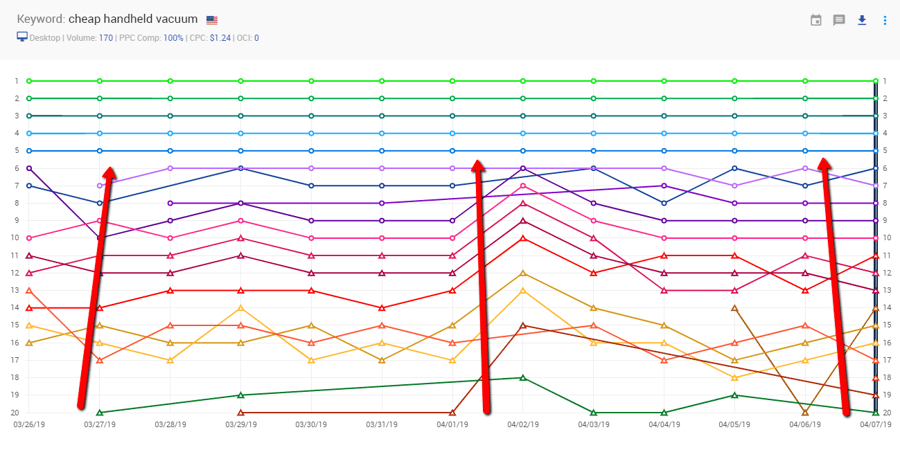
I’ve seen this trend where the top three to five sites rarely budge on hundreds of thousands of keywords over the past five years.
Everyone else below them bounces around like kids in a jumpy house.
Do you want to play with the children in the bouncy house and never know where your site will turn up each day? Or do you want to play with the big boys and secure a spot at the top and know you can rely on the rankings to bring in the money?
Because of this finding, you need to hone in on your SEO efforts if you want to rank. The guys at the top aren’t going to be easily knocked down.
Here is another take on the image above. This is a screenshot of volatility for eCommerce websites.

Volatility is the measure of how much chaos is happening on the 1st page of Google for a keyword. It measures day to day how many sites came in and out, moved up and down, etc.
Anything under 30 is considered calm. Anything above 30 starts to get a bit more “volatile.”
Knowing this calmness is a trend, it’s going to be hard to break into the top 10, let alone the top 5.
That’s why I say if, deep down, you know you can’t compete, then save your money and time and go after something you can get a more comfortable foothold in that might produce returns faster for you.
Or, you can gain an advantage to see what’s working and do SEO correctly from the get go by doing SERP analysis with tools like SERPWoo that will let you reverse engineer what’s going on in your specific niches.
Action Item for You:
Can you withstand a war? Are you even prepared for a long term battle? You have to make sure you are prepared and willing to do whatever it takes to grab those top spots in the SERPs.
6) Backlinks Count, But Under Certain Conditions
No aha moment here, right?
We’ve learned that backlinks help with SEO many years ago.
But, it isn’t about the metrics that most people throw around when it comes to backlinks. You know, things like:
- TF (Trust Flow)
- PR (Page Rank)
- DA (Domain Authority)
- Alexa Rank
- Etc., etc., etc.
Nope, it’s all about how relevant the site that links to you is for the content on your page.
So, if you sell blue Yeezys, you better have another site that links to you that is all about Yeezys or shoes in general.
Getting a high authority TF, PR, DA, or Alexa link won’t do as much for you as a highly relevant link will.
Even a relevant URL link will beat out a highly authoritative domain link.
Meet Grindstone; he did a study on backlinks much in the same way I did a study on eCommerce SERPs. Here’s what he found:
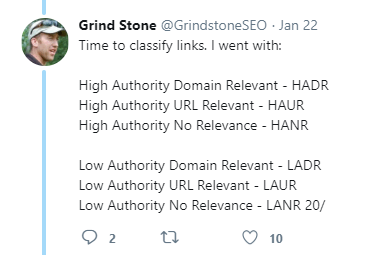
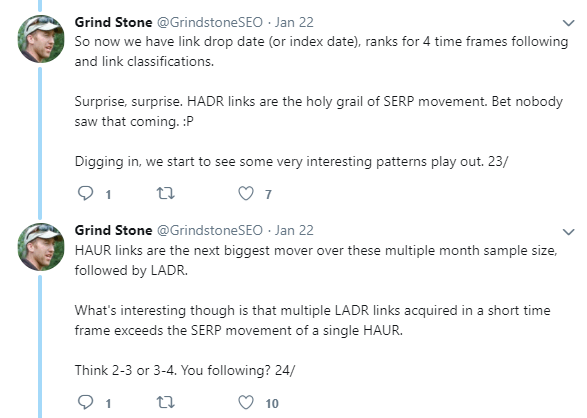
Interesting.
If you want to read the complete analysis, you can read Grindstones complete Twitter storm here.
All those links sold at shady forums and discount sites are all measured in high authority metrics. Metrics like high TF, high PR, high DA, high Alexa, etc.
But, they don’t rank as good as low authority, highly relevant links.
And it doesn’t stop there, folks.
These websites are ranking with backlinks that hardly use a keyword for the anchor.
I’ll let Grindstone take it away again.
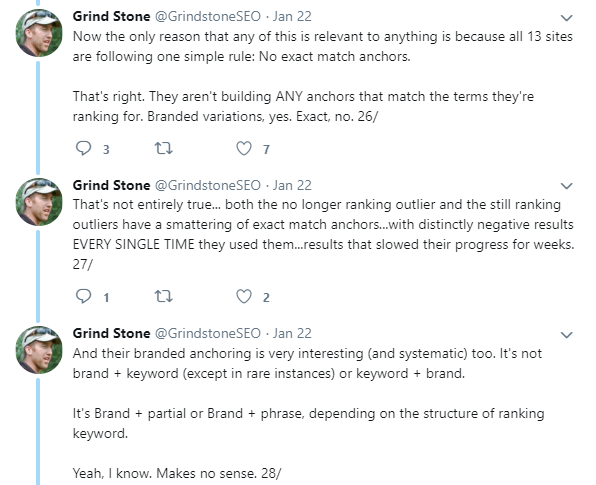
Yep, hardly anyone that’s ranking is building links with their keywords in the anchors. It’s brand terms, brand terms with a partial keyword, or brand terms with a phrase for the anchor back.
The backlinks that are helping websites rank today are all relevant on their topic and the anchors being used are brand terms, or brand terms with partial terms and phrases.
And, none of this would be possible if you weren’t watching your own SERPs and digging into the data that Google is giving you.

Action Item for You:
Get more backlinks, but only from other sites that are highly relevant to you.
Put more work into branded anchors along with your keywords, instead of just using keyword anchors you want to rank for.
Conclusion
I hope this article has given you a few insights into what’s working right now for eCommerce .
Hopefully, you can take these lessons and apply them in later years to understand what efforts you need to plan for when ranking your next website.
And remember, don’t listen to generic SEO advice. Make sure it’s current and relevant to your industry.


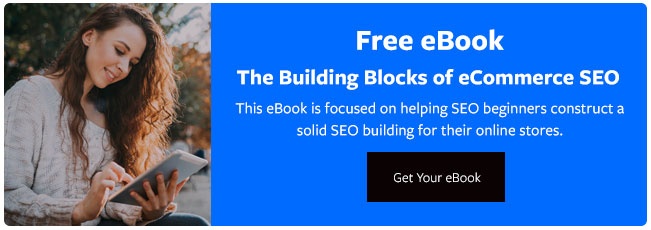


Leave a reply or comment below